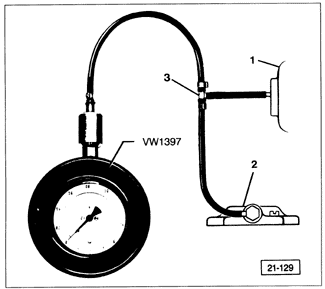7.2 Testing Turbocharger Wastegate and Blow-Off Valve
The wastegate and blow-off valve are both normally closed, opening only when the boost pressure becomes too high. Not opening will allow the turbocharger to create too much boost pressure, which can cause prompt and serious engine damage. Opening too soon will limit boost pressure and reduce engine power.
Before testing wastegate and blow-off valve regulating functions, inspect the system for leaks and make sure that the control line to the wastegate is not plugged, loose, or leaking. To achieve meaningful test results, other engine performance factors such as injection timing and valve clearance should be within specification or adjusted correctly. The engine should be warmed up to normal operating temperature for the pressure tests.
Boost pressure specifications in this test procedure are "overpressure" specifications, given in relation to normal atmospheric pressure. In other words, zero pressure on the gauge is actually atmospheric pressure or 1 bar (14.5 psi) absolute pressure. A boost pressure specification of 0.70 bar (10.2 psi) as given in this manual would be read as 0.70 bar (10.2 psi) on an overpressure type gauge, or 1.70 bar (24.7 psi) on an absolute pressure gauge. Make sure to identify the gauge type and, if necessary, convert the specifications and readings to the same scale using the conversion graph given in Fig. 7-4.
| Fig. 7-4. | Conversion graph for converting between absolute pressure scale and overpressure scale. Specifications given are for overpressure. |

|
To test:
| 1. | Install a pressure gauge. On turbo diesel models, use a T-fitting to install the gauge in the air pressure line that links the air intake manifold with the boost enrichment device on the fuel injection pump. See Fig. 7-5. On ECO diesel models, connect the gauge directly to the intake manifold port. |
| Fig. 7-5. | Pressure gauge connection on turbo diesel models. Use T-fitting (3) between intake manifold port (1) and boost enrichment valve (2) on injection pump. On ECO diesels connect to manifold port (1) only. Use long hose to place gauge in passenger compartment. Gauge shown is Volkswagen special tool no. VW 1397. |

|
| 2. | Install a tachometer so that it can be seen from the driver's seat. See IGNITION. |
| 3. | Place the pressure gauge inside the vehicle where it can be easily seen from the driver's seat. Take care not to kink or pinch the hose. |
| 4. | Start the engine and open the gauge's valve, if so equipped. |
| 5. | To road test, use the brakes or a steep hill to hold the car at a steady 37 mph (60 kph) with the accelerator floored; in 2nd gear with a manual transmission, or in drive range 1 with an automatic transmission. |
WARNING-
For the sake of safety during a road test, take a helper along to read the gauge, or if the gauge is equipped with a valve, close the valve at peak boost and record the value later.
|
| 6. | If testing on a dynamometer, hold the engine at 4000 rpm with the accelerator pedal floored; in 3rd gear with a manual transmission, or in drive range 2 with an automatic transmission. |
CAUTION-
To avoid unnecessary engine strain, the road-test or dynamometer measurement time should be limited to a maximum of 10 seconds.
|
| 7. | The boost pressure should be 0.64 to 0.72 bar (9.3 to 10.4 psi). If the pressure indicated is greater, the waste-gate is faulty and the turbocharger should be replaced. If the maximum boost pressure is lower, the blow-off valve may be sticking open. Proceed with the steps which follow. |
| 8. | Disconnect the blow-off valve outlet hose from the intake air duct. Plug the hose (inside diameter approximately 25 mm or 1 in.) and secure the plug with a hose clamp, as shown in Fig. 7-6. |
| Fig. 7-6. | Blow-off valve outlet hose disconnected and plugged (arrow). |

|
| 9. | Repeat the test. Correct boost pressure at this point indicates that the blow-off valve is faulty and should be replaced. |
| 10. | On the ECO diesel, boost pressure which is still below specification indicates that the turbocharger is faulty and should be replaced. |
| 11. | On the turbo diesel, if boost pressure is still low, pinch off the hose to the boost enrichment valve and repeat the test. If boost pressure rises, the injection pump is faulty. If boost pressure is still low, the turbocharger is faulty and should be replaced. |
To replace blow-off valve:
| 1. | Allow the engine to cool. |
| 2. | Disconnect the outlet hose from the blow-off valve and loosen the clamp securing the valve to the intake manifold. |
| 3. | Remove the valve and O-ring from the intake manifold. |
| 4. | Installation is the reverse of removal. Always use a new O-ring. |
|


